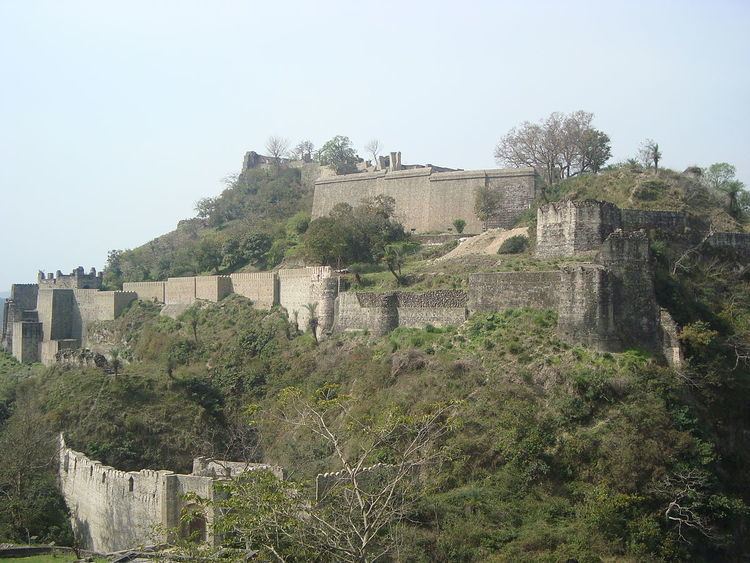 | ||
Address Old Kangra, Kangra, Himachal Pradesh 176001 Hours Open today · 9AM–6PMFriday9AM–6PMSaturday9AM–6PMSunday(Holi)9AM–6PMHours might differMonday(Holi)9AM–6PMHours might differTuesday9AM–6PMWednesday9AM–6PMThursday9AM–6PM Similar Kangra Valley, Masroor Rock Cut Temple, Dhauladhar, Mata Brajeshwari Devi, Dal Lake | ||
Kangra fort
The Kangra Fort is located 20 kilometers from the town of Dharamsala on the outskirts of the town of Kangra, India.
Contents
- Kangra fort
- India himachal pradesh 400 year old kangra fort dharamshala sight seeing attraction
- History
- Layout
- Location
- References
India himachal pradesh 400 year old kangra fort dharamshala sight seeing attraction
History
The Kangra Fort was built by the royal Rajput family of Kangra State (the Katoch dynasty), which traces its origins to the ancient Trigarta Kingdom, mentioned in the Mahabharata epic. It is the largest fort in the Himalayas and probably the oldest dated fort in India.
The fort of Kangra resisted Akbar's siege in 1615. However, Akbar's son Jehangir successfully subdued the fort in 1620. Kangra was at the time ruled by Raja Hari Chand Katoch of Kangra (also known as Raja Hari Chand II) Mughal Emperor Jahangir with the help of Suraj Mal garrisoned with his troops.
The Katoch Kings repeatedly looted Mughal controlled regions, weakening the Mughal control, aiding in the decline of Mughal power, Raja Sansar Chand-II succeeded in recovering the ancient fort of his ancestors, in 1789. Maharaja Sansar Chand fought multiple battles with Gurkhas on one side and Sikh King Maharaja Ranjit Singh on the other. Sansar Chand used to keep his neighboring Kings jailed, and this led to conspiracies against him. During a battle between the Sikhs and Katochs, the gates of the fort had been kept open for supplies.
The Gurkha army entered the opened scarcely armed gates in 1806. This forced an alliance between Maharaja Sansar Chand and Maharaja Ranjit Singh. Because of the insufficiency of the need within the fort after a long war and unable to procure any, the Gurkhas left the Fort. The Fort remained with the Katochs until 1828 when Ranjit Singh annexed it after Sansar Chand's death. The fort was finally taken by the British after the Sikh war of 1846.
A British garrison occupied the fort until it was heavily damaged in an earthquake on 4 April 1905.
Layout
The entrance to the fort is through a small courtyard enclosed between two gates which were built during the Sikh period, as appears from an inscription over the entrance. From here a long and narrow passage leads up to the top of the fort, through the Ahani and Amiri Darwaza (gate), both attributed to Nawab Saif Ali Khan, the first Mughal Governor of Kangra. About 500 feet from the outer gate the passage turns round at a very sharp angle and passes through the Jehangiri Darwaza.
The Darsani Darwaza, which is now flanked by defaced statues of River Goddesses Ganga and Yamuna gave access to a courtyard, along the south side of which stood the shrines Lakshmi-Narayana Sitala and Ambika Devi. In between these shrines is a passage that leads up to the palace. It is one of the most beautiful forts in India.
Location
The fort is right next to Kangra town. 32.1°N 76.27°E / 32.1; 76.27 The fort stands on a steep rock in Purana Kangra (translates to Old Kangra) dominating the surrounding valley, built strategically at the "sangam" confluence (places where two rivers meet) of Banganga and Majhi rivers. It is said that Kangra belongs to one who owns the fort.
Also near to old Kangra is the famous Jayanti Mata temple on a hill top. The Temple was built by the General of the Gorkha Army, Bada Kaji Amar Singh Thapa. Also close to entrance is a small museum which exhibits the history of Kangra fort.
Adjoining the Fort is the Maharaja Sansar Chand Katoch Museum run by the Royal Family of Kangra. The Museum also provides audio guides for the fort and the museum and has a cafeteria.
